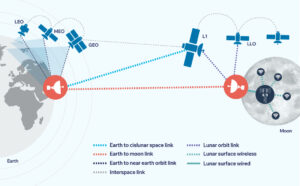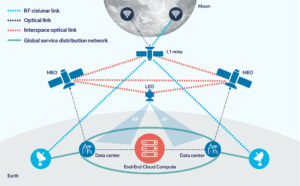

Abubakar Manzo
Space & Connectivity


The Moon is emerging as a focal point for the next frontier in space exploration, with the lunar economy projected to reach USD 170 billion by 2040.[1] The recent growing interest in cislunar exploration is mostly driven by scientific activities, space mining, and continued exploration of the solar system via lunar bases. The term “cislunar space” refers to the region situated between Earth and its moon, spanning up to 12 times the distance from Earth to Geostationary Orbit (GEO), and encompassing an area approximately 2,000 times larger than Earth-to-GEO space.[2] Notably, between 2018 and 2030, more than 40 cislunar missions are planned to take off, involving about 80 spacecraft belonging to 10 different space agencies and commercial operators.[3] Among the planned missions, some remote autonomous exploration cislunar missions are already underway, while human visits to the Moon are planned to begin by 2025, with permanent bases expected in the 2030s.[4]


Developing communication infrastructure in the unique atmospheric, soil, and topographic conditions of lunar and cislunar environments introduces a number of technical challenges, ranging from propagation delays to space weather and debris. These challenges represent the various complexities that engineers will need to address to design high-performance cislunar communication systems capable of supporting a wide variety of cislunar missions.
The Artemis programme seeks to establish a permanent lunar base. Alongside this, there is a lunar orbital outpost project called Gateway that could eventually lead to a crewed mission to Mars. Meanwhile, LUPEX aims to search for water near the moon’s south pole. There are also plans for missions to the shielded zone of the moon (SZM), which has no direct line of sight with the Earth.
Continuous connectivity among cislunar space assets is critical to the success of these programmes. Earth/space communication has always been a critical facilitator of space exploration, enabling successful missions and, where necessary, ensuring human safety. In the same vein, cislunar communication aims to facilitate the transmission and exchange of data, information, and signals between spacecraft and ground-based stations within cislunar space. The anticipated growth in cislunar activities necessitates flexible and resilient communications to enable networking for effective command and control of spacecraft, interactions between space crews, lunar assets, and the Earth, data collection, and accurate tracking of cislunar space assets and debris for effective space traffic management (STM).
Beyond the functional communication requirements of lunar surface operators and users, there is also a need for situational data collection and processing, pre-processing of large datasets, and transmitting processed data to Earth. For instance, communication networks empower lunar space crews to retain contact with mission control on Earth, operate and control lunar rovers and landers, and transfer data on mission parameters and status. These use cases underscore the critical role of cislunar communications in supporting a wide range of lunar exploration activities.
The cislunar communication frameworks currently under development aim to provide relay and data services in a distributed network architecture similar to the internet. These emerging cislunar space networks (CSNs) are being designed to enable communications to and from Earth for lunar assets on the surface, as well as in low lunar orbits (LLO). This can be achieved either by direct links to Earth stations or through lunar orbiting relay satellites, where users can maintain a connection with the larger network, enabling communications in real-time.
One prominent example is the LunaNet architecture, developed by NASA’s Space Communications and Navigation (SCaN) programme, which is a network-centric architecture that promotes maximum interoperability to deliver mission-critical services, including networking between space assets, positioning, navigation, and timing services. This could ultimately provide users with near-instantaneous situational alerts and user-initiated measurements for scientific research.
The most likely cislunar communication needs should fit one of the following scenarios, illustrated by the figure below.[5]


The lack of atmosphere removes a restriction on the choice of transmission medium. Integrating RF (radio frequency) and FSO (free space optical) systems provides a robust and complementary approach to address the challenges of cislunar communications. Since both RF and FSO communication have their own merits and demerits, a combination of the two can be used to establish reliable, high-speed, and efficient communication links in the cislunar environment. RF links offer reliable connectivity over long distances and can go through obstacles in space, ensuring coverage throughout the cislunar region, whereas FSO links can enable more localised and very high-bandwidth connectivity. Combining RF and FSO technologies could allow for more efficient use of resources and enable redundancy and resilience, ensuring communication continuity even in partial system failures or adverse propagation conditions.


Describing space orbits and trajectories mathematically presents a challenge. The accepted method to describe objects orbiting the Earth up to GSO – the so-called Two-Line Elements (TLEs) – cannot accurately describe cislunar trajectories. As we consider objects farther away from GSO, this approach will no longer be viable, due in large part to the growing influence of other planets and large bodies.
To accurately describe an object in cislunar space, the gravitational forces of three bodies will have to be considered: the Earth, the Moon, and the object itself. This approach is called the three-body problem (3BP). The paths followed by objects in cislunar space are referred to as trajectories, not orbits, as they are not circular (or elliptical), not repeating, and without a fixed orbital plane, except in special cases.[7] This makes cislunar trajectories difficult to describe using the tools that are currently available.


Additionally, due to the gravitational pull from other bodies in space, spacecraft at most locations in cislunar space do not remain on the same trajectory for a period long enough to achieve mission objectives. The fuel/propellant budget will be too high for most missions due to frequent station-keeping (using onboard thrusters to keep a spacecraft in its predetermined trajectory). The best orbits for communication spacecraft in space are orbits that repeat their trajectory in a fixed period – repeating natural orbits, such as those around the five Lagrange points[9] shown in Figure 3. These orbits are highly attractive as they are relatively predictable and easier to exploit to establish and maintain stable links with other stations.
The scope and complexity of cislunar space activities pose significant challenges to the development of a robust and scalable cislunar network architecture. Cislunar assets may operate in diverse orbits and trajectories, requiring a communications architecture with dynamic configuration and advanced tracking capabilities. Additionally, the planned cislunar missions will potentially bring with them a growing number of spacecraft, lunar landers, and lunar bases, resulting in increased demand for communication network services. The development of a scalable network in cislunar space will be complicated further by the following technical challenges:
In addition to the technical challenges, building cislunar communication systems requires navigating a complex regulatory landscape. Early moon exploration was carried out by a very limited number of participants, so interference was easily managed. The growing number of national and international missions, coupled with the growing interest of private enterprises, means a harmonised regulatory framework for cislunar communication becomes paramount.
Cislunar communication systems require specific spectrum allocations with protection from other services. This is especially true for Earth-to-cislunar links. Apart from the physical constraints due to the required increase in power for these links, there are also regulatory limits imposed by the International Telecommunications Union (ITU) on space services operating in non-geostationary orbits (NGSO). The details of these limitations are provided in Articles 21 and 22 of the ITU’s Radio Regulations in a bid to “ensure the use of the radio-frequency spectrum is rational, equitable, efficient, and economical – all while aiming to prevent harmful interference between different radio services”.[12] However, current regulations are largely aimed at managing compatibility on and around Earth and may not be fully appropriate for the cislunar environment.
For example, as spectrum is a scarce resource, there are limitations on the amount of spectrum resources that can be used by any space service, while the total power radiated towards existing satellites is also limited depending on the frequency band used and the type of service concerned. Furthermore, critical services for scientific research, like the Radio Astronomy service, also have special protection limiting the spectrum and power usage of any space service intending to use the spectrum allocated to these services.
These limits make achieving the required transmission power and bandwidth for cislunar communications extremely challenging in the current regulatory environment, especially for higher data rate use cases.
Cislunar communication involves a variety of communication links, all of which will require access to spectrum. These include the following:
Communication between satellites, as well as between the Earth and Earth-orbiting satellites, is already well-defined and understood within the spectrum regulatory environment. However, communications between Earth and the lunar surface, or between the lunar surface and satellites, are not well defined from a regulatory perspective.
The Radio Regulations do not define cislunar communications and do not have specific provisions allowing for their use. Certain provisions apply to lunar services (see Section V of Article 22, for example), but their focus is on the protection of radioastronomy, rather than enabling communications. Nevertheless, there are now several satellite filings from multiple administrations within the Master International Frequency Register (MIFR). These satellite filings were mostly created with Earth-to-cislunar links using the frequencies allocated to the Space Research Service (SRS), Space Operations, and Inter-Satellite Service (ISS).
Lunar surface and LLO-to-lunar surface links are currently either being filed under these services or Article 4.4 of the Radio Regulations – a declaration that the filing is under no protection and no interference basis. These links are not expected to operate with enough power to interfere with other links on the Earth’s surface. However, studies are required to ensure the compatibility of these space services with others on Earth and around cislunar space. This approach could only be viable in the short term, hence the need for dedicated allocations for cislunar communication services.
Existing spectrum allocations under the SRS, ISS, and Space Operations could be suitable to support the envisaged communications. Given the necessary protection required for some essential deep space services and the general constraint on bandwidth availability, the extent to which utilising these allocations would be fully appropriate for cislunar communication networks is unclear. As such, the identification of new bands, or the modification of current allocations, may be necessary to fully support the proposed missions.
Considering the increased interest in space exploration activities in lunar orbit and on the lunar surface, the World Radiocommunication Conference 2023 (WRC-23) has agreed on a new Agenda Item 1.15 (Resolution 680 (WRC-23)) to study possible new or modified space research service (space-to-space) allocations in several frequency bands between 300 MHz and 28 GHz by WRC-27. This has the goal of supporting the future development of communications on the lunar surface, as well as between lunar orbit and the lunar surface.
WRC-27 Agenda Item 1.15 will also analyse the spectrum needs, technical and operation characteristics, protection criteria of this service, and its compatibility with other incumbent radiocommunication services. Propagation characteristics for lunar surface systems and lunar-orbiting systems operating in the targeted bands and protection of Radio Astronomy Services (RAS) on the Earth and in the shielded zone of the Moon (SZM) will also be studied as part of this agenda item.
Where appropriate allocations do not exist, consideration at WRC-27 (or another future WRC) may result in suitable allocations being made. In any case, there is a clear interest in ensuring appropriate regulatory considerations are included within the Radio Regulations to fully enable cislunar communications.
Reliable connectivity will be critical to the success of the envisioned cislunar space missions. The recent renewed interest in cislunar space missions, coupled with the increased investment from both the public and private sectors, has energised the space sector. However, myriad technical, policy, and regulatory challenges need to be addressed to enable the establishment of reliable, robust, and secure cislunar communication systems. We invite current and future cislunar communications users, service providers, regulators, and policymakers to leverage the following insights as we seek to catalyse humanity’s next great leap into deep space exploration.
International collaboration
Geopolitical issues can be a serious impediment to achieving the required level of international collaboration, which can lead to the building of critical technologies in silos. When this occurs, the variance in technological capabilities among nations can pose interoperability challenges. Operators should ideally form clusters and share resources, making it easier and more cost-effective to deploy communication services where needed.
We must also ensure that activities on the lunar surface and beyond are sustainable, both in terms of safe operations and resource gathering. Consequently, before any significant deployment of lunar infrastructure, questions concerning the ownership of properties/land on the moon and other planets must be addressed. The absence of a comprehensive traffic management system also poses challenges for the safe and efficient use of cislunar space. To address this, developing a cislunar traffic management framework is essential.
However, overcoming these challenges necessitates sustained diplomatic engagement. This will ensure that all involved feel secure while fostering a shared commitment to navigating the complexities of cislunar communication advancements for the collective benefit of all spacefaring nations.
Technological innovations
Just like the envisioned future networks on Earth, the development of a scalable cislunar space communications architecture will likely leverage advanced networking protocols, artificial intelligence for dynamic resource allocation, and improved signal processing techniques. To overcome the technological limitations and achieve the required quality of service and security for cislunar communication links, there is an urgent need for technological advancements in launch capability, spacecraft design and manufacturing, and communications systems in space and on the ground. Governments and private companies should allocate funding and resources to research, develop, and deploy cutting-edge communication solutions tailored for the cislunar environment, leveraging advancements in areas such as optical communications, software-defined radios, and advanced software engineering.
Interference management
Current spectrum limitations make achieving the required transmission power and bandwidth for cislunar communications extremely challenging, especially for higher data rate use cases. As the number of users grows, coordination between systems will be required. However, in the short term, the level of coordination necessary should be limited. For example, coordination between users may be required for lunar surface-based mobile services, noting that interoperability standards explored later may determine exactly how this occurs. These could be coordinated in a similar way to existing Earth-based systems.
Spectrum management
The regulations around communications between the Earth and the lunar surface, or between the lunar surface and satellites, are not well defined. The use of SRS, ISS, and space operation frequency allocations is not going to solve current bandwidth availability issues. As such, the identification of new bands, or the modification of current allocations, will be necessary for effective cislunar communications. We urge all stakeholders to follow Agenda Item 1.15 ahead of WRC-27 and actively contribute to facilitating new or modified space research service (space-to-space) allocations across various frequency bands between 300 MHz and 28 GHz by WRC-27. These allocations are essential to support the future development of communications on the lunar surface and between lunar orbit and the lunar surface.
Licensing and authorisation
The extent to which services on the lunar service will need to be licensed and authorised is currently unclear. A similar uncertainty also applies regarding who will be responsible for doing so, as the ownership of outer space is shared by all nations. The ITU is better positioned to coordinate the licensing and authorisation of cislunar communication systems. In this regard, licensing of cislunar communication services will be treated as space radio services. Hence, we call on nation-states to uphold the spirit of collaboration and use the ITU to authorise and regulate communications in cislunar space.
Standardisation and interoperability
As human activity in cislunar space increases, there is likely to be a growing need for reliable communications infrastructure to support missions from multiple agencies. To this end, agencies are beginning to develop standardisation in their approaches to cislunar communications. Having a set of standards is vital to enable an open, evolving, and cooperating lunar communications architecture designed to be interoperable to ensure compatibility. We believe that establishing a global standardisation mechanism to support and promote the acceptance of common standards for cislunar communication systems is essential.
Ultimately, commercial partnerships are required between cislunar space operators to provide diverse global hardware and software solutions for spacecraft, ground stations, connectivity, and cloud storage. This necessitates cooperation and active participation from all nation-states, as well as the private sector, which is a driving force behind lunar exploration and activity. Public-private partnerships should be encouraged as the complexity of delivering cislunar space services requires risky and intensive long-term investments unsuitable for the current technology funding models.
Companies should explore new business models and commercial opportunities enabled by cislunar communications, such as communication relay services, data transmission, and supporting lunar and deep space exploration missions. It is essential that companies properly understand the competition, solutions offered, investment landscape, and regulatory challenges to capitalise on the promises of the lunar economy.

